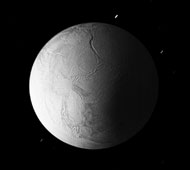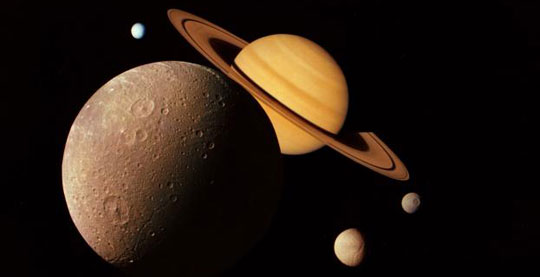UAB Scientist Offers New Views of Space
By Jennifer Ghandhi
More than 800 million miles from Earth, the space orbiter Cassini is busy shooting pictures of the planet Saturn and its moons. Thousands of these in-flight images are available online on Cassini’s home page—but the spacecraft’s oeuvre includes many recordings that cannot be appreciated with human eyes alone. They’re snapshots of data gathered by an onboard instrument called the Ultraviolet Imaging Spectrograph (UVIS), which records measurements of reflected UV light that is invisible to humans. On Earth, UV rays can be harmful, but in space, UV data is immensely useful to astronomers measuring the composition of distant planets.
Right now, NASA scientists don’t have a way to effectively interpret the UVIS data Cassini is relaying, so they’ve tapped UAB physicist Perry Gerakines, Ph.D., to help. He was awarded a three-year, $408,000 grant to create thin, icy films of materials thought to be on Saturn’s moons and then analyze them with a custom-built UVIS of his own. “We’re going to measure these spectra—the way different compounds absorb and reflect light—in the hopes that we can use them to interpret the spectra we see from the icy moons on the rings of Saturn,” Gerakines says.
Frozen in Time
 |
Perry Gerakines |
After a seven-year journey, Cassini reached Saturn in 2004. With its initial research mission complete, the space orbiter is now devoting further attention to Titan and Enceladus, two of the more than 52 moons circling Saturn. Gerakines says data from Cassini’s UVIS will confirm what compounds make up the moons and, more important, reveal information about the size, shape, and texture of the ice grains on the surfaces of Enceladus and Titan.
Learning more about the moons will help scientists unearth clues about the solar system’s history. “The Saturn system is so far away from the sun that it’s in deep freeze all the time,” Gerakines explains, adding that when materials from space land on the moons, they’re frozen in place. “By learning about the composition of these moons, we learn about the composition of objects that were in the solar system when it formed around 5 billion years ago.”
 |
Moon Rivers—and Oceans?In addition to revealing the secrets of the solar system’s past, Gerakines’s project could lead to discoveries about the system’s present—including the possibility for life. Read more. |
Fingerprints of Light
Gerakines isn’t kidding when he calls the Saturn system a cold corner of the universe. Because the moons are located nine times farther from the sun than Earth, compounds that are usually liquid or gas here are frozen solids there. So to take comparable UVIS measurements of materials such as water, ammonia, methane, carbon dioxide, and carbon monoxide at UAB, Gerakines first has to freeze them using a closed-cycle helium cryostat. This instrument uses the expansion of helium to cool a small, transparent window to the temperatures of Saturn’s moons. The sample gas is then frozen onto this window as a very thin film.
After cooling down the gases so that they condense into icy films, Gerakines and a graduate student will subject the films to their own custom-built UVIS. “The spectrometer works by splitting a beam of light into its different wavelengths,” Gerakines says. Different materials absorb and reflect light at varying wavelengths, giving each compound a unique “fingerprint” spectrum.
By measuring spectra of known compounds through the icy films, Gerakines will create a library of identifying data. Amanda Hendrix, a Cassini UVIS instrument scientist from NASA’s Jet Propulsion Laboratory, will then use computer models to convert Gerakines’s lab results into data that can be compared with Cassini’s measurements on the icy moons. And the applications of Gerakines’s work may go far beyond Saturn. The library will be useful for scientists gathering UV data through future visitors to the outer solar system—an idea that excites Gerakines. “There are other missions to other places,” he says, “including the New Horizons mission that will fly by Pluto in April 2015.”
